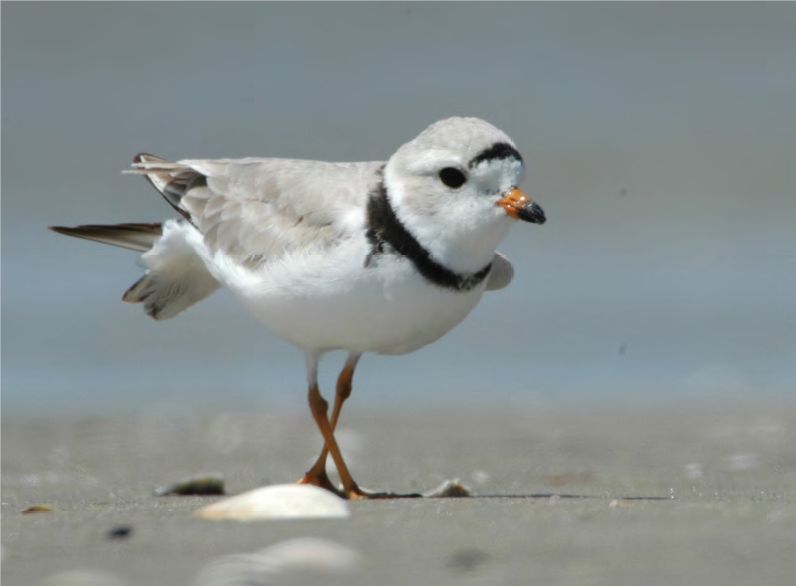Other Features
Natural Heritage Inventory
 "Piping Plover (USFWS)"
"Piping Plover (USFWS)"In addition to rare plants, animals and high-quality examples of natural communities, the Wisconsin Natural Heritage Inventory (NHI) tracks certain other natural features. These features, such as bat hibernaculum and temporary ponds, provide important habitats for specific plants and animals and are places where a catastrophic event at any one location could significantly impact many common and rare species.
Critical recovery areas and ranges have been designated for federally listed species to aid species recovery efforts.
- Bat Hibernaculum
-
A Bat Hibernaculum is a site where bats hibernate over the winter and are most often in caves or abandoned mines. They can include one or many species of bats, including rare and non-rare species. It is essential to protect these sites because bats will return yearly to the same hibernation site and can occur in huge numbers.
- Bird Rookery
-
A Bird Rookery is an area where more than one pair of birds nest in a group. The number of nests can vary from just a few to hundreds and can include one to many different species of birds. Sites can have rare and non-rare species. The breeding time will vary based on the species present at the site. Rookeries are typically inaccessible, including forests, shrub communities, wetlands adjacent to water (lakes, rivers or streams), and islands. These sites are important as large numbers of breeding individuals can be found in a single place.
- Ephemeral Pond
-
Ephemeral ponds are small fishless pools with impeded drainage, usually in forest landscapes, that hold water for a short time following snowmelt and spring rains but typically dry out by mid-summer. They flourish with productivity during their brief existence. Ephemeral ponds, also referred to as vernal pools, provide critical breeding habitat for invertebrates and many amphibians, such as wood frogs and several salamanders, because they lack the fish that would typically prey on them, their egg masses and tadpoles. They also provide feeding, resting, and breeding habitats for songbirds and a food source for many mammals. In many ways, they contribute to the biodiversity of a woodlot, forest stand, and the larger landscape.
Common wetland plants found in temporary ponds include yellow water crowfoot, mermaid weed, Canada blue joint grass, floating manna grass, spotted cowbane, smartweeds, orange jewelweed, and sedges. Trees adjacent to ephemeral ponds provide various benefits, such as maintaining cool water temperatures, preventing premature drying, and contributing to the food web. The annual leaves input from these trees helps provide a detritus-based food source for various invertebrates.
- Herp Hibernaculum
-
A Herp Hibernaculum is where snakes, turtles, frogs or salamanders hibernate communally over the winter. They may have one or many different species of herptiles and can include both rare and non-rare species. These sites are important as many individuals can be found anywhere.
- Mussel Bed
-
Mussel Beds are unique areas within a river reach with a large muss concentration, often including rare and non-rare species. These beds correlate with suitable substrate conditions and the presence of host species and can occur in small to large rivers. They are significant due to their diversity and species richness in a discrete area.
- Migratory Bird Concentration Site
-
Migratory Bird Concentration Sites are essential resting and feeding areas for birds as they fly between their breeding and wintering grounds. These areas can also be locations where large numbers of migrating birds often become concentrated due to prevailing winds and water barriers. Sites are used by many different species, both rare and non-rare.
- Karner Blue Federal High Potential Range
-
The Karner Blue Butterfly (Lycaeides melissa samuelis) is a Federally Endangered and Wisconsin Special Concern Species. The Karner Blue Butterfly High Potential Range (HPR) was developed through a model to identify areas where the Karner Blue Butterfly has the highest probability of occurrence. It does not represent the species distribution.
Visit Karner Blue Butterfly to view the HPR map and to learn more about Wisconsin's Karner Blue Butterfly Habitat Conservation Plan.
- Federal - Hine's Emerald Critical Habitat Area
-
Critical habitat is a specific geographic area with features essential for conserving a threatened or endangered species and may require special management considerations or protection. When a species is proposed for listing as endangered or threatened under the Endangered Species Act (ESA), these areas may be offered for designation as "critical habitat." The title may also include areas not currently occupied but needed for species recovery.
In Wisconsin, 8,841 acres have been designated critical habitats for the Hine's emerald dragonfly.
For more information, visit U.S. Fish and Wildlife.
- Federal - Piping Plover Critical Habitat Area
-
Critical habitat is a specific geographic area(s) that contains features essential for conserving a threatened or endangered species and may require special management considerations or protection. When a species is proposed for listing as endangered or threatened under the Endangered Species Act (ESA), these areas may be offered for designation as "critical habitat." The title may also include areas not currently occupied but needed for species recovery.
In Wisconsin, 45.3 kilometers of shoreline have been designated critical habitat for the piping plover. All essential habitat unit boundaries extend 500 meters (1640 feet) inland from the ordinary high water line. However, the inland edge of the area that contains the primary constituent elements may vary depending on the extent of the open dune system. This area is needed to provide foraging habitat and incorporate cobble pans between the dunes where piping plovers occasionally nest.
For more information, visit U.S. Fish and Wildlife.
